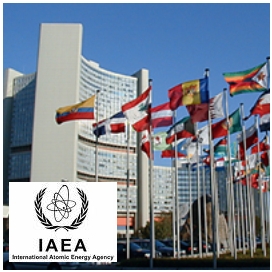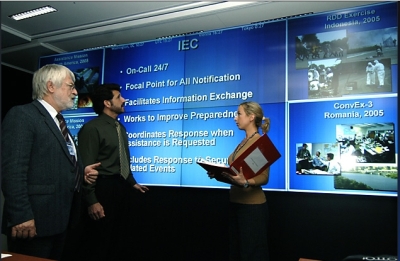Radiation Tidbits - The International Atomic Energy Agency at 50
Written by: Yeung Siu-wai
When the issue of nuclear energy or nuclear weapon is brought up, the media often refer to International Atomic Energy Agency (IAEA). The IAEA is the United Nation's "Nuclear Watchdog" and is the world's center of cooperation in the nuclear field. This year is the 50th Anniversary of the IAEA. Let us look at the role of IAEA.
- What is International Atomic Energy Agency (IAEA)?
- What is IAEA's mission?
- Why IAEA is called the world's 'nuclear watchdog'?
- What role does the IAEA take in case of radiation emergency?
- How does the IAEA contribute towards radiation protection in Hong Kong?
- What is International Atomic Energy Agency (IAEA)?
The IAEA was created in 1957 as an independent body in the United Nations (UN) family. Its creation was in response to concerns that more countries had mastered the technology to develop nuclear weapons. At the same time, it was considered that peaceful nuclear applications in medicine and generation of electricity should be promoted.

The IAEA Headquarters in Vienna
(Source: D. Calma/IAEA) - What is IAEA's mission?
The IAEA's mission covers three main areas:
- Safeguard and Verification: inspection to verify that nuclear material and activities are not for military purposes.
- Safety and Security: establishment of safety standards, codes, and guides and provision of assistance to States to apply them.
- Science and Technology: provision of technical and research support for nuclear applications in health, agriculture, energy, environment and other fields.
- Why IAEA is called the world's 'nuclear watchdog'?
The IAEA inspects nuclear and related facilities under safeguard agreements with more than 140 States. IAEA inspectors regularly visit declared nuclear facilities to check that nuclear material is not diverted for weapons or other explosive purposes.


IAEA inspectors examining the fuel storage of a nuclear power plant.
(Source: D. Calma/IAEA) - What role does the IAEA take in case of radiation emergency?
The IAEA had established in 2005 an Incident and Emergency Centre (IEC) to serve as the global focal point for communication and response to nuclear and radiological incidents or emergency. In case of emergency, apart from facilitating information exchange, it would also call upon relevant organizations, such as the World Meteorological Organization (WMO), to provide assistance to concerned parties, such as forecasts of radioactive dispersion.

In nuclear and radiological incidents, the IEC would stay open and
serve as the focal point in respect of emergency response.
(Source: D. Calma/IAEA) - How does the IAEA contribute towards radiation protection in Hong Kong?
The contributions from IAEA are mainly in the following 4 areas :
- The IAEA has established guidelines on radiological measurements and contingency response. These guidelines served as the basis in the development of the contingency plan in Hong Kong.
- The IAEA organizes from time to time inter-comparison exercises which Hong Kong participates to assure the quality of radiation monitoring in Hong Kong.
- Hong Kong also participated in the exercises organized by the IAEA that tested and evaluated the exchange of information and coordination of assistance on the international scale during a nuclear emergency. The IAEA also sent experts to observe the exercises held in Hong Kong.
- In the unlikely event of a nuclear accident, in addition to the information that Hong Kong will receive from the Mainland through the established notification system, the Observatory will also receive notification from the IAEA.
 Back to Top
Back to Top